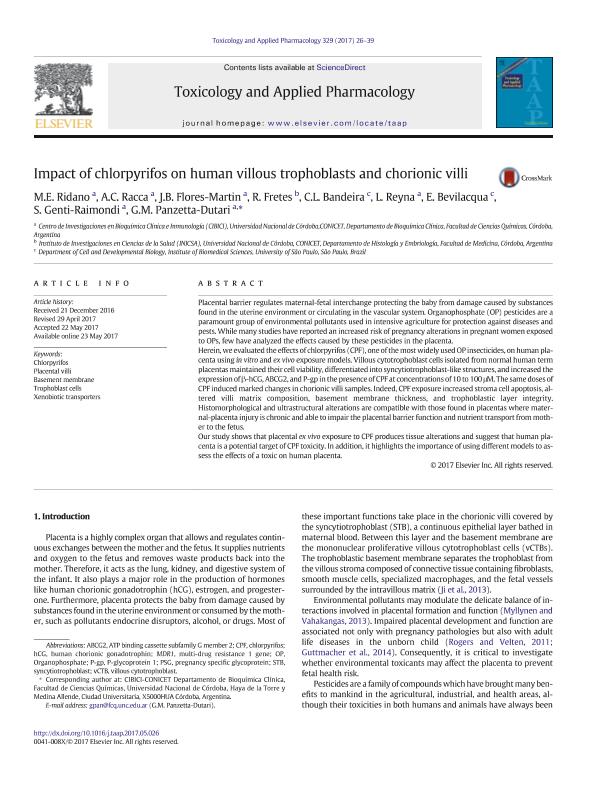Mostrar el registro sencillo del ítem
dc.contributor.author
Ridano, Magali Evelin

dc.contributor.author
Racca, Ana Cristina

dc.contributor.author
Flores Martín, Jésica Belén

dc.contributor.author
Fretes, Raquel María

dc.contributor.author
Bandeira, C. L.
dc.contributor.author
Reyna, Luciana

dc.contributor.author
Bevilacqua, E.
dc.contributor.author
Genti de Raimondi, Susana

dc.contributor.author
Panzetta-Dutari, Graciela Maria del Valle

dc.date.available
2018-06-12T18:31:21Z
dc.date.issued
2017-08-15
dc.identifier.citation
Ridano, Magali Evelin; Racca, Ana Cristina; Flores Martín, Jésica Belén; Fretes, Raquel María; Bandeira, C. L.; et al.; Impact of chlorpyrifos on human villous trophoblasts and chorionic villi; Academic Press Inc Elsevier Science; Toxicology and Applied Pharmacology; 329; 15-8-2017; 26-39
dc.identifier.issn
0041-008X
dc.identifier.uri
http://hdl.handle.net/11336/48388
dc.description.abstract
Placental barrier regulates maternal-fetal interchange protecting the baby from damage caused by substances found in the uterine environment or circulating in the vascular system. Organophosphate (OP) pesticides are a paramount group of environmental pollutants used in intensive agriculture for protection against diseases and pests. While many studies have reported an increased risk of pregnancy alterations in pregnant women exposed to OPs, few have analyzed the effects caused by these pesticides in the placenta.Herein, we evaluated the effects of chlorpyrifos (CPF), one of the most widely used OP insecticides, on human placenta using in vitro and ex vivo exposure models. Villous cytotrophoblast cells isolated from normal human term placentas maintained their cell viability, differentiated into syncytiotrophoblast-like structures, and increased the expression of β-hCG, ABCG2, and P-gp in the presence of CPF at concentrations of 10 to 100 μM. The same doses of CPF induced marked changes in chorionic villi samples. Indeed, CPF exposure increased stroma cell apoptosis, altered villi matrix composition, basement membrane thickness, and trophoblastic layer integrity. Histomorphological and ultrastructural alterations are compatible with those found in placentas where maternal placenta injury is chronic and able to impair the placental barrier function and nutrient transport from mother to the fetus. Our study shows that placental ex vivo exposure to CPF produces tissue alterations and suggest that human placenta is a potential target of CPF toxicity. In addition, it highlights the importance of using different models to assess the effects of a toxic on human placenta.
dc.format
application/pdf
dc.language.iso
eng
dc.publisher
Academic Press Inc Elsevier Science

dc.rights
info:eu-repo/semantics/openAccess
dc.rights.uri
https://creativecommons.org/licenses/by-nc-sa/2.5/ar/
dc.subject
Chlorpyrifos
dc.subject
Placental Villi
dc.subject
Basement Membrane
dc.subject
Trophoblast Cells
dc.subject
Xenobiotic Transporters
dc.subject.classification
Otras Ciencias Biológicas

dc.subject.classification
Ciencias Biológicas

dc.subject.classification
CIENCIAS NATURALES Y EXACTAS

dc.subject.classification
Otras Ciencias Biológicas

dc.subject.classification
Ciencias Biológicas

dc.subject.classification
CIENCIAS NATURALES Y EXACTAS

dc.title
Impact of chlorpyrifos on human villous trophoblasts and chorionic villi
dc.type
info:eu-repo/semantics/article
dc.type
info:ar-repo/semantics/artículo
dc.type
info:eu-repo/semantics/publishedVersion
dc.date.updated
2018-06-11T12:58:12Z
dc.journal.volume
329
dc.journal.pagination
26-39
dc.journal.pais
Estados Unidos

dc.journal.ciudad
Amsterdam
dc.description.fil
Fil: Ridano, Magali Evelin. Consejo Nacional de Investigaciones Científicas y Técnicas. Centro Científico Tecnológico Córdoba. Centro de Investigaciones en Bioquímica Clínica e Inmunología; Argentina
dc.description.fil
Fil: Racca, Ana Cristina. Consejo Nacional de Investigaciones Científicas y Técnicas. Centro Científico Tecnológico Conicet - Córdoba. Centro de Investigaciones en Química Biológica de Córdoba. Universidad Nacional de Córdoba. Facultad de Ciencias Químicas. Centro de Investigaciones en Química Biológica de Córdoba; Argentina
dc.description.fil
Fil: Flores Martín, Jésica Belén. Consejo Nacional de Investigaciones Científicas y Técnicas. Centro Científico Tecnológico Córdoba. Centro de Investigaciones en Bioquímica Clínica e Inmunología; Argentina
dc.description.fil
Fil: Fretes, Raquel María. Consejo Nacional de Investigaciones Científicas y Técnicas. Centro Científico Tecnológico Conicet - Córdoba. Instituto de Investigaciones en Ciencias de la Salud. Universidad Nacional de Córdoba. Instituto de Investigaciones en Ciencias de la Salud; Argentina
dc.description.fil
Fil: Bandeira, C. L.. Universidade de Sao Paulo; Brasil
dc.description.fil
Fil: Reyna, Luciana. Consejo Nacional de Investigaciones Científicas y Técnicas. Centro Científico Tecnológico Córdoba. Centro de Investigaciones en Bioquímica Clínica e Inmunología; Argentina
dc.description.fil
Fil: Bevilacqua, E.. Universidade de Sao Paulo; Brasil
dc.description.fil
Fil: Genti de Raimondi, Susana. Consejo Nacional de Investigaciones Científicas y Técnicas. Centro Científico Tecnológico Córdoba. Centro de Investigaciones en Bioquímica Clínica e Inmunología; Argentina
dc.description.fil
Fil: Panzetta-Dutari, Graciela Maria del Valle. Consejo Nacional de Investigaciones Científicas y Técnicas. Centro Científico Tecnológico Córdoba. Centro de Investigaciones en Bioquímica Clínica e Inmunología; Argentina
dc.journal.title
Toxicology and Applied Pharmacology

dc.relation.alternativeid
info:eu-repo/semantics/altIdentifier/url/http://linkinghub.elsevier.com/retrieve/pii/S0041008X17302326
dc.relation.alternativeid
info:eu-repo/semantics/altIdentifier/doi/http://dx.doi.org/10.1016/j.taap.2017.05.026
Archivos asociados
